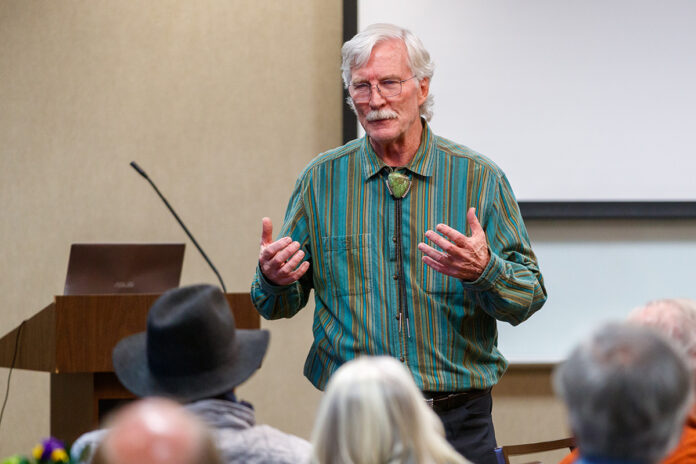The Verde Valley Archaeology Center hosted a talk by Todd Bostwick, Ph.D., titled “Stonehenge: Old and New Ideas About the World’s Most Famous Megalithic Temple” on Thursday, March 7, in West Sedona.
Bostwick has been a professional archaeologist for 43 years and is currently the Director Emeritus of Archaeology at VVAC where he served nine years as director. Prior to this, he was the city archaeologist for Phoenix for 21 years at the Pueblo Grande Museum and National Historic Landmark.
VVAC Executive Director Monica Buckle introduced the lecture by relating Stonehenge to archaeology in the Verde Valley. She drew parallels between Stonehenge and the solar and lunar calendars found in the Verde Valley, specifically the calendar at the Crane Petroglyph Site at the historic V-V Ranch.
Bostwick said that Stonehenge is one of the largest neolithic monuments in Europe, and was also a place to view astronomical phenomena, a healing place, a theater in the round and a musical performance venue, with all of its functions relating to the health of the community.
Stonehenge was first erected around 3,000 BCE, but was repeatedly rebuilt over the next 1,500 years,demonstrating its importance. Its three main features are the standing stones, the henge or ditch-and-bank combination that surrounds the site and the avenue aligned with the sunrise on the summer solstice.
Bostwick said that the archaeological record shows that people from different communities around the area would gather at Stonehenge for feasting, although this apparently did not take place within the stone circle, which was reserved for ritual and ceremonial use.
A new major excavation, the Stonehenge Riverside Project, took place beginning in 2004 under the supervision of archaeologist Mike Parker Pearson. Bostwick said that little concrete information was available about the site prior to this survey, which encompassed 45 projects over six years and was the largest archaeological excavation ever undertaken in England.
Stonehenge and the similar complex of Avebury are considered the two most important archaeological sites in the historic county of Wessex in south central England, and Bostwick used the sites to illustrate how peer polity competition can drive technological innovation.
The oldest monuments within the Stonehenge World Heritage Site are long barrows, a type of burial mound, which predate the famous circle by about 500 years. One of the similar barrows at Avebury incorporated a chamber with special acoustics and a large closing stone to seal it.
The Stonehenge site also incorporates a cursus, a long, linear space designated by trenches and banks. The Stonehenge greater cursus is oriented along an east-west line with the position of the sunrise at equinox and extends for 1.75 miles. William Stukeley, a 16th-century antiquarian, was the first to call it by the Roman name, as he thought it looked like a Roman racecourse. Bostwick said this space may have been used to delineate zones of separation between the living and the dead and that the people demarcated landscape to create spaces that had social meaning to them.
Bostwick said that around 200 people were buried inside the stone circle and that its primary function was as a cemetery. One of the burials, known as the Stonehenge archer, was a local 30-year-old male. He was buried with flint arrow points and a stone wrist protector, and three arrow points found in his body indicated he was shot from three different directions. Bostwick speculated that he could have been a sacrifice.
Bostwick also jokingly addressed the theory that aliens built Stonehenge, saying that if aliens had built it, then it would have been perfect, which it is not, as there are many errors present.
“They’re great engineers but they’re humans, not aliens,” Bostwick said.
Bostwick said that while a circle was the easiest shape to create, the circle of Stonehenge could also have a constructed cultural meaning related to the cyclical nature of life.



